Bringing Data Analytics into the Audit Program
Business leaders in all industries are flocking to data analytics in huge numbers. The advantages of data-based decision making and automation technologies, coupled with advancements in accessible software platforms, have solidified data analytics as a core component of modern business strategy.
Internal Audit executives, in particular, are increasingly using the insights gained from data analytics to make strategic and complex business decisions, particularly those concerning cost and risk mitigation, operational innovations and process improvements. Audit executives are deriving value from analytics by using it to zero in on key audit activities, improve the efficiency of audits, reduce the cost of compliance, provide continuous monitoring of controls, identify and recover misused funds, and mitigate the risk of fraud and abuse.
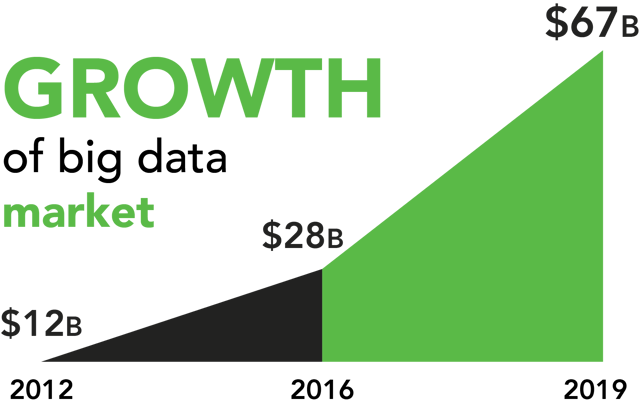
The explosive growth in the popularity of data analytics, however, has caused some companies to integrate analytics into their Internal Audit function without proper planning. These companies, though acting with the best of intentions, are often in a hurry to catch up to their peers and end up building their data analytics programs upon weak foundations. While these programs may deliver some value, they are not providing the maximum return on the investment in analytics. Instead of performing continuous monitoring, these companies are building labor-intensive systems that rarely improve the business or reduce its risk.
Here, we will outline five steps for implementing an audit analytics program that is driven by business needs, has buy-in from key stakeholders, and delivers real, consistent value to decision makers.
Build Buy-In for Audit Analytics with Incremental Goals
Implementing a data analytics program or ramping up an existing program is an exercise in reforming business culture. It is a disruptive technology that challenges you to think about your business, its problems, and the potential solutions with a fresh perspective and new inputs. While analytics programs for marketing and sales initiatives are more commonplace since they provide more tangible and immediately useable data, audit-centric analytics can be a tougher sell. Because it challenges an old way of thinking, it is sometimes met with resistance by executives outside of Internal Audit. These executives have spent their careers making decisions based on intuition and business acumen alone. Data analytics can explode that model, particularly around fraud and risk mitigation. As an internal auditor, your goals should be to (1) win the hearts and minds of executives and (2) have them champion analytics through the rest of the organization.
Think Small: Start with Manageable Analytics
To win over executives, start small. Build buy-in with manageable analytics that promise quick value and a high rate of return. Before pitching analytics to these skeptical executives, spend time identifying analytics that present a likely scenario for quick value. This often means developing analytics that promise high business impact using the data that is most easily accessible and requires the least amount of effort. Tackle an area where there is known overspending or an area that is susceptible to fraud, waste, and abuse. To further reduce cost, considering using a hosted analytics provider for your pilot program - and invest in your own data analytics software only when you are ready and fully committed.

Audits of financial processes such as Travel and Entertainment Expense (T&E) reporting or accounts payable can easily open the door to data analytics. If executives can see the potential of analytics in these audits, it can grease the skids as you work to incorporate analytics into more complex aspects of internal audit. This is an area ripe with opportunity, especially if the systems and controls are not robust.
View Data as a Process, Not a Number
The quantity of data collected in most corporate environments today would have been unimaginable just a decade ago, and this accumulation of data is growing at an unprecedented rate. Corporate data, when sifted, sorted, transformed and analyzed, can provide incredibly valuable insights to an organization. However, in a rush to begin the analysis, data analytics teams often speed through the planning and data collection phases, only gathering the most obvious and accessible data. If the right data is not planned for and collected up front, it can lead to major problems later in the project.
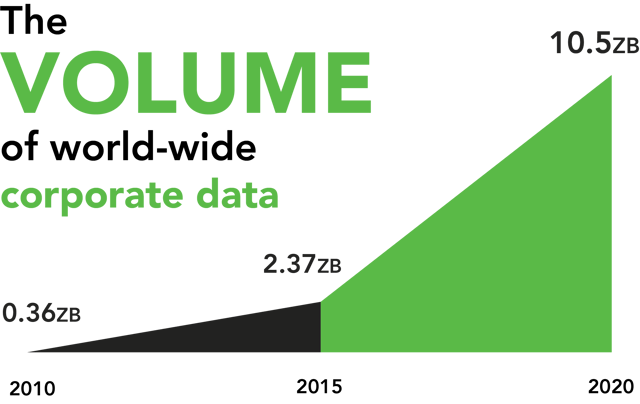
Re-Think Your Data
Data should not be thought of in its final, resting form – it should be thought of as an end-to-end process, from creation through collection, transmission, storage, and access. To decide which of these data streams to target, envision the final result of your planned analytic, and identify all of the possible streams of data that could lead to or affect the result. After the data streams have been identified, you can begin to answer the many questions sure to arise along the path of each data stream – Who owns the data? What transformations have been applied since the source? Where is it stored? How do I access it? How do I transmit it?
This thought exercise is a necessary step in getting an accurate inventory of the data needed for the project and will significantly reduce the chances of project delays and budget overruns down the line. By planning through the project from start to finish and identifying all the people, processes, and data involved, Internal Audit can avoid costly setbacks that can manifest in the middle of ill-planned projects.
Invest Time in Planning and Exploration
Many organizations attempt to shortcut the time spent on planning exploration by simply collecting all data. Others hope to “make do” or “jump start” the process by collecting only the most obvious, accessible data. The largest portion of time must be invested up front by gaining buy-in, planning the project, identifying data streams, and exploring additional analytics opportunities within the business problem. Spending more time on the planning phase often lessens the overall time spent on each analytics initiative, as it clears the obstacles that create more significant delays in an ongoing project. Moreover, this often presents additional analytics opportunities, uncovers low-effort improvements and enhancements, and delivers results that would not have been uncovered by standard testing procedures.
Work to move your organization from Typical to Ideal, shifting time to the front end and ensuring efficient and reliable outcomes at the end.
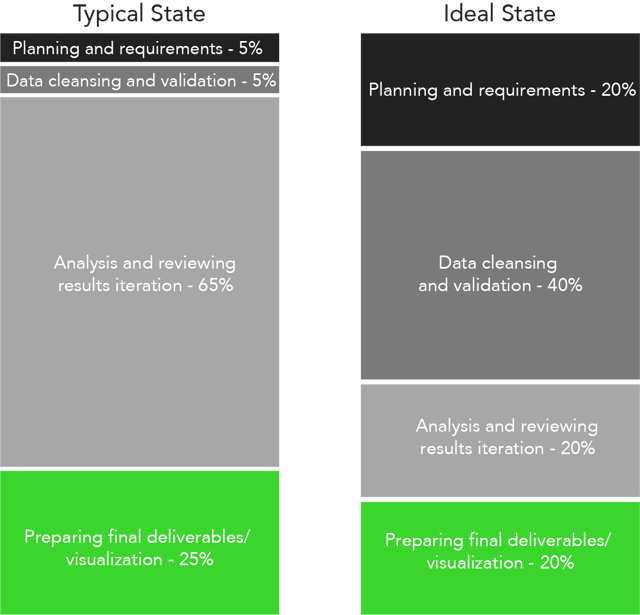
Build Your Audit Analytics Team with Skillsets Rather Than Job Titles
One of the greatest challenges in building out Internal Audit’s data analytics capabilities is assembling a skilled, sustainable team. This challenge is compounded by the lack of qualified candidates on the market and the intense demand for their services – there are simply not enough qualified professionals to meet the need. As a result, the salaries for these professionals have risen, making it difficult for smaller Internal Audit functions to justify these additional team members. Internal Audit functions must tackle this problem by taking a more strategic approach to building their data analytics teams from within.
Approach the development of your team by thinking about skillsets, not people. To build a program with durability and influence, you must account for several core skillsets. These skillsets can be acquired over time as your data analytics capabilities become more advanced and more substantial. As your program matures, you will find yourself looking for new skillsets and needing to invest a larger share of your internal audit budget in your data analytics team.
In general, budgeting for audit analytics should be no different than any other budgeting or resourcing decision. A portion of your annual internal audit budget should be allocated to analytics development based on the desired projects, level of effort required, cost of resources and relative potential for cost savings. The following chart should serve as a guide for assembling and growing your core team.
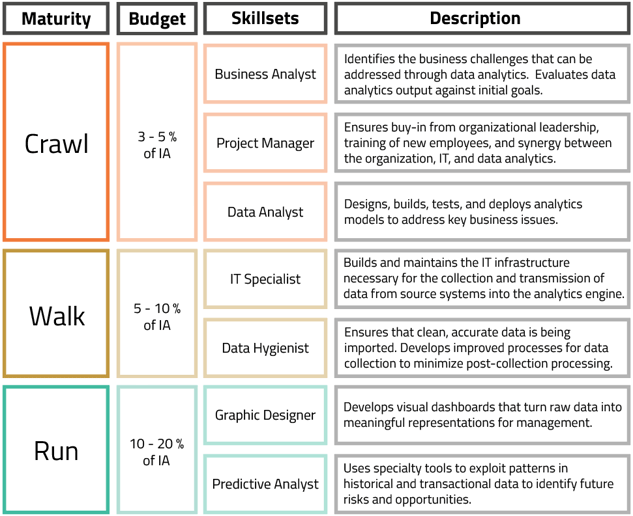
Of course, sourcing these employees and skillsets can be a challenge, given the high demand for skilled resources and the limited pool of qualified candidates. For smaller companies, hiring experienced individuals with multiple skillsets can pay dividends. Training existing employees is also key to developing audit analytics maturity. Other companies may choose to occasionally supplement their internal team with outside support.
The Value of a Mature AUDIT Analytics Team
A recent Focal Point survey of Fortune 50 to Fortune 2000 companies highlighted two key success factors for companies building an analytics team internally. First, companies with mature IA data analytics programs typically have resources specifically dedicated to data analytics. Second, program maturity correlates with the size of the data analytics team in relation to the overall Internal Audit function. For companies building an analytics team internally, Focal Point recommends following both of these success factors – hire dedicated analytics resources and make the analytics team a significant portion of your overall Internal Audit function.
Because the needs of each organization are different, and the role played by Internal Audit can vary, there is not one perfect model for a data analytics team. However, strategically acquiring key skillsets and slowly growing the size and role of your analytics team within Internal Audit is the best approach for developing the maturity of your analytics program – from crawl to walk to run. Operating in a “run” state, your data analytics program should add significant strategic value to Internal Audit and far exceed the initial needs of the organization.
Get proactive about Dirty Data Early
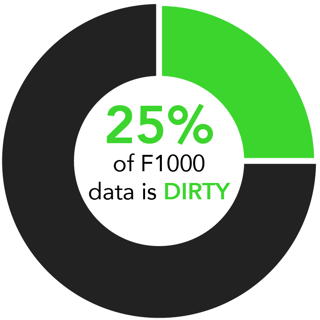
- Be proactive and drive organizational change around data governance.
- Plan for and actively address dirty data within analytics initiatives.
Some of the more common causes of dirty data in analytics projects include:
- Lack of standardized formats or normalization for description fields
- Critical fields left blank
- Lack of common keys between tables for correlation
- Double byte enabled applications for foreign languages
- Poorly designed logic leading to misattributed characteristics in the database
All of these factors can have a significant impact on an analytics initiative if they are not properly considered in the planning phases of the project.
Data Governance: the key to long-term audit analytics succesS
Overcoming dirty data requires a two-pronged approach. First, it must be taken into account on the front end by being explored and tested in the early phases, prior to analysis. More importantly, it prevents misinformed business decisions based on poor data analysis.
Second, dirty data can be minimized if the organization invests in proper data governance. Data governance is the enterprise-wide program for managing the availability, integrity, and security of company data. Because of inadequate data governance, many organizations struggle to efficiently collect, clean and process the data needed to complete their analytics objectives.
Proper data governance may include:
- Clearly communicated objectives, processes, and metrics
- Data quality controls and issue resolution processes
- Clear and documented data conventions
- Well understood roles and responsibilities for analytics resources
- Data governance training
- Clear change management process
- Periodic architecture reviews
The Next Frontier: Visualizing your Audit Analytics
Even after implementing a data analytics function, many Internal Audit departments struggle to provide larger insights to business executives. The results are too often esoteric, narrow, or complex; or, more frequently, the data is not presented in a way that executives understand or can easily digest. Because of this challenge, investments in data analytics technology often fail to deliver a sufficient return on investment, as decision makers are not apt to rely on manual spreadsheets with hundreds or thousands of data points to make business decisions.

This fundamental problem has led to the meteoric rise in the use of visual analytics and dashboarding tools, like Tableau. Visual analytics is a method of interactive data exploration, allowing you to see the results of the analytics and further explore and analyze the reasons behind the results. It is a means for understanding data and enabling one’s audience to leverage data to come to independent conclusions.
Meaningful Exploration
When executives and other employees are given self-service access to the visual data, they are able to answer many of their own questions without the direct involvement of the analytics team. The interactivity of visual analytics opens the door to discovering trends, anomalies, opportunities, and causes and effects that may have been missed otherwise.
Visualizing Data
Visual analytics can take many traditional reports and display them side-by-side for comparison and analysis, or combine data for visual representations of correlations. Performed manually, these processes can take far longer and still not deliver the intended results. Furthermore, advanced visual analytics gives users the opportunity for near real-time analysis, empowering executives to make the right decisions quickly.Most importantly, visual analytics gives executives and auditors a powerful tool to ensure that the data being gathered and analyzed delivers strategic and significant value for the organization. As you undertake each data analytics project, be sure to consider how the output can be visualized to deliver clear insight and support business decisions. Design dashboards so that they communicate data in the language of your executives, speaking directly to the business challenge at the heart of the initiative. With proper planning and a modest investment in tools and expertise, your organization can provide a far greater level of insight to executives making critical business decisions.
Cost Savings
Aside from the opportunity to more easily identify fraud, waste and abuse, visual analytics can reduce the burden of reporting for your data analytics staff. Generating reports requires substantially less effort, and the opportunity to explore the data minimizes follow-up report requests.
Conclusions
To generate value for Internal Audit and the organization, you must avoid the pitfalls that so frequently delay or derail the growth of data analytics within Internal Audit function. These challenges, and the key takeaways, include:
- Failing to gain sufficient buy-in from executives
Tip: Build buy-in with manageable analytics that promise quick value and high rate of return
- Being overwhelmed by the quantity of data
Tip: Invest in adequate planning to reduce the risk of project delays and project overruns.
- Building a team by default instead of strategically designing one
Tip: Assemble key skillsets and grow your team according to your business and audit needs
- Losing the battle against dirty data
Tip: Address dirty data upfront through better data governance and proper planning.
- Failing to generate insights from the analytics
Tip: Use data visualization to ensure that business executive derive real insight from the work of the analytics team
In the end, the return on data analytics is dependent upon Internal Audit’s dedication to proper resourcing, strategic partnerships and planning. By approaching each data analytics project strategically and dedicating proper time to resources and planning, you will be well on your way to delivering significant business value for your organization.
We're here to help
Interested in speaking with a data analytics expert? Looking for a pilot program to kick-off your audit analytics initiative? Focal Point offers expert consultations with internal audit and business leaders to discuss analytics strategy, in-flight projects, and affordable hosted options. Browse our full list of data analytics services here.










